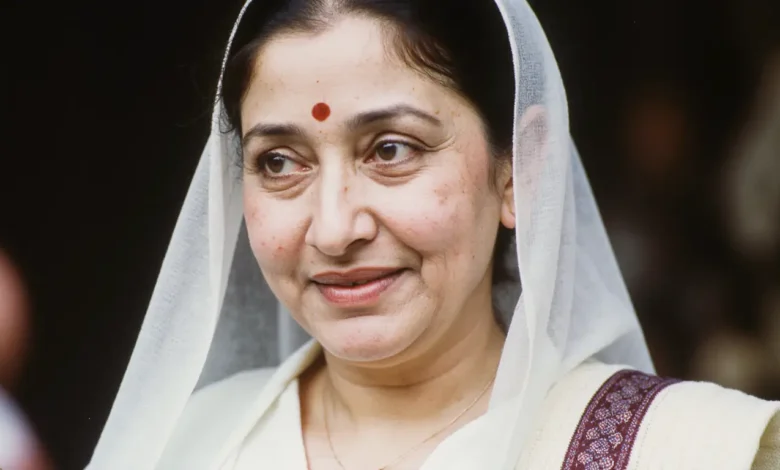Sandhya Shantaram Legacy in Indian Cinema: The Golden Era Remembered

Sandhya Shantaram legacy in Indian cinema remains one of the most profound stories in the history of India’s cultural evolution. Her passing in October 2025 reignited discussions about the timeless grace, innovation, and emotional depth that defined her artistry. Beyond the headlines of her death, her name stands as a powerful symbol of how cinema, when merged with authenticity and passion, can transcend generations and shape national identity.
Sandhya Shantaram legacy in Indian cinema is not merely about the films she acted in but about how she embodied the spirit of an era when cinema was more than entertainment — it was a reflection of post-independence India’s soul. Her performances in Jhanak Jhanak Payal Baje, Do Aankhen Barah Haath, Navrang, and Pinjara captured the tension between tradition and modernity, spirituality and sensuality, realism and dream.
Lina Khan and the Future of AI Regulation: How the FTC Is Redefining Digital Accountability
table of contents
The Core of Sandhya Shantaram’s Legacy in Indian Cinema
At the center of Sandhya Shantaram legacy in Indian cinema lies her ability to merge art and discipline. Unlike many actresses of her time, Sandhya was trained in classical dance, a skill that became her cinematic identity. Her collaboration with her husband, the visionary filmmaker V. Shantaram, was not a mere partnership but a creative symbiosis. He directed; she interpreted. Together, they crafted cinematic poetry that blurred the line between performance and devotion.
Her portrayal in Navrang (1959) remains an artistic landmark. Sandhya’s dual role as a devoted wife and a muse symbolized India’s duality: the moral rigidity of society versus the yearning for freedom of expression. The legendary dance sequence “Are Ja Re Natkhat” wasn’t just choreography — it was emotional storytelling through motion, color, and rhythm. This dance became a timeless emblem of cinematic elegance.
The Emotional Resonance of Sandhya Shantaram Legacy in Indian Cinema
One reason Sandhya Shantaram legacy in Indian cinema endures is her emotional transparency. In Do Aankhen Barah Haath, even though she had a brief appearance, her presence added moral gravity to the film’s theme of human redemption. She didn’t rely on glamour; her appeal came from expressive eyes and graceful gestures that conveyed more than words could.
Sandhya’s career was never driven by fame but by purpose. Each role she played carried an undertone of spiritual sincerity — a reflection of how Indian cinema once prioritized values and cultural pride over commercial success. She belonged to an era when actors saw cinema as a tool for enlightenment, not just applause.
The Craft and Discipline Behind the Art
Sandhya Shantaram legacy in Indian cinema also represents discipline — a trait often overshadowed by the glitz of Bollywood. She practiced dance routines for months, sometimes barefoot on rugged studio floors, refusing body doubles or shortcuts. This level of artistic commitment defined her integrity as an actress.
Her collaboration with Rajkamal Kalamandir Studio became the crucible of creativity. Every production she was part of introduced a new cinematic experiment — innovative lighting, color usage, and visual metaphors that reflected both Indian tradition and global artistry. Sandhya’s disciplined dedication helped shape India’s cinematic visual language in the mid-20th century.
Why the Sandhya Shantaram Legacy in Indian Cinema Still Matters Today
In the age of digital cinema and social media influencers, Sandhya Shantaram legacy in Indian cinema stands as a reminder that timeless art comes from authenticity, not algorithms. Her passing has sparked nostalgia among older generations and curiosity among younger audiences discovering her films for the first time.
Modern filmmakers in India are now revisiting her performances to study the choreography, camera movement, and color symbolism in her films. Universities have begun referencing Navrang and Jhanak Jhanak Payal Baje in cinema courses focused on narrative aesthetics. In a sense, her death has revived her art.
Her story resonates with women in the film industry today who are reclaiming agency in their creative expression. Sandhya’s subtle defiance — performing bold, emotionally charged roles in a conservative society — paved the way for actresses to blend strength and sensitivity.
The Cultural and Spiritual Dimensions
The Sandhya Shantaram legacy in Indian cinema cannot be separated from India’s spiritual tradition. Her performances often carried mythological undertones — a dance between the earthly and divine. She portrayed women not as passive beauties but as embodiments of Shakti (divine feminine energy).
Through her art, she reminded audiences that dance, color, and music were extensions of the sacred. Each of her films was a prayer in motion — visual hymns to the nation’s evolving identity. For a country healing from colonial trauma, Sandhya’s art offered emotional reconciliation and pride.
Media Response and National Mourning
When the news of her passing broke in October 2025, Indian media reacted not with mere obituaries but with reverence. Social media flooded with clips of her dance scenes, and younger creators on YouTube and Instagram started reinterpreting her iconic moves. The Sandhya Shantaram legacy in Indian cinema became viral once again, bridging seven decades of cinematic evolution.
Prominent figures from politics and film, including cultural ministers, expressed condolences, emphasizing that her contribution went beyond acting — she was a cultural educator. Her funeral at Shivaji Park in Mumbai was attended by artists, scholars, and fans who grew up watching her on screen.
Global Reflections
In the international context, Sandhya Shantaram legacy in Indian cinema highlights how classical Indian aesthetics found global resonance. Her performances introduced non-Indian audiences to Kathak-inspired movement, elaborate costumes, and visual storytelling rooted in myth and modernity.
During film festivals in Europe in the 1960s, her films represented India’s creative rebirth. Even today, retrospectives in global art museums occasionally feature Do Aankhen Barah Haath and Navrang as case studies in postcolonial cinematic identity.
Her artistry demonstrated that Indian cinema was not a derivative of Hollywood but an independent school of thought — emotional, spiritual, and visually poetic. In a globalized world where speed often replaces sincerity, her legacy reminds artists that slowness, devotion, and precision can be revolutionary.
Conclusion
Sandhya Shantaram legacy in Indian cinema is not just history — it’s a living philosophy. It teaches that art survives not because of fame, but because of feeling. Her passing may mark the end of a life, but it also marks the rebirth of attention to the values she embodied: discipline, cultural pride, and artistic truth.
The golden era of Indian cinema was not built by technology but by individuals like Sandhya who treated every frame as a sacred offering. Her legacy now belongs not only to India but to the world that learns from her quiet brilliance.
Frequently Asked Questions (FAQ)
Q1: What defines the Sandhya Shantaram legacy in Indian cinema?
Her legacy is defined by the fusion of classical dance, emotional storytelling, and spiritual symbolism that elevated Indian cinema from entertainment to art.
Q2: Why did her work in films like Navrang and Jhanak Jhanak Payal Baje become timeless?
Because they merged aesthetics, color, and rhythm to portray India’s cultural soul — something modern films rarely capture with such authenticity.
Q3: How did her death impact the Indian film community?
Her death sparked nationwide remembrance and revived interest in India’s cinematic golden age, inspiring retrospectives and educational discussions.
Q4: What global influence did her art achieve?
Her performances introduced the world to India’s unique storytelling methods and visual grandeur, influencing cross-cultural appreciation of Indian cinema.
اكتشاف المزيد من Feenanoor
اشترك للحصول على أحدث التدوينات المرسلة إلى بريدك الإلكتروني.











